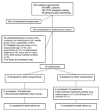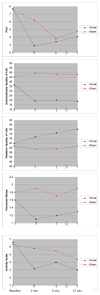Japanese-style acupuncture for endometriosis-related pelvic pain in adolescents and young women: results of a randomized sham-controlled trial
- PMID: 18794019
- PMCID: PMC2610346
- DOI: 10.1016/j.jpag.2007.07.008
Japanese-style acupuncture for endometriosis-related pelvic pain in adolescents and young women: results of a randomized sham-controlled trial
Abstract
Study objective: To assess feasibility, and collect preliminary data for a subsequent randomized, sham-controlled trial to evaluate Japanese-style acupuncture for reducing chronic pelvic pain and improving health-related quality of life (HRQOL) in adolescents with endometriosis.
Design: Randomized, sham-controlled trial.
Settings: Tertiary-referral hospital.
Participants: Eighteen young women (13-22y) with laparoscopically-diagnosed endometriosis-related chronic pelvic pain.
Interventions: A Japanese style of acupuncture and a sham acupuncture control. Sixteen treatments were administered over 8 weeks.
Main outcome measures: Protocol feasibility, recruitment numbers, pain not associated with menses or intercourse, and multiple HRQOL instruments including Endometriosis Health Profile, Pediatric Quality of Life, Perceived Stress, and Activity Limitation.
Results: Fourteen participants (out of 18 randomized) completed the study per protocol. Participants in the active acupuncture group (n = 9) experienced an average 4.8 (SD = 2.4) point reduction on a 11 point scale (62%) in pain after 4 weeks, which differed significantly from the control group's (n = 5) average reduction of 1.4 (SD = 2.1) points (P = 0.004). Reduction in pain in the active group persisted through a 6-month assessment; however, after 4 weeks, differences between the active and control group decreased and were not statistically significant. All HRQOL measures indicated greater improvements in the active acupuncture group compared to the control; however, the majority of these trends were not statistically significant. No serious adverse events were reported.
Conclusion: Preliminary estimates indicate that Japanese-style acupuncture may be an effective, safe, and well-tolerated adjunct therapy for endometriosis-related pelvic pain in adolescents. A more definitive trial evaluating Japanese-style acupuncture in this population is both feasible and warranted.
Figures


Similar articles
-
Development of protocols for randomized sham-controlled trials of complex treatment interventions: Japanese acupuncture for endometriosis-related pelvic pain.J Altern Complement Med. 2008 Jun;14(5):515-22. doi: 10.1089/acm.2007.0826. J Altern Complement Med. 2008. PMID: 18537469 Free PMC article. Clinical Trial.
-
Electrodermal measures of Jing-Well points and their clinical relevance in endometriosis-related chronic pelvic pain.J Altern Complement Med. 2009 Dec;15(12):1293-305. doi: 10.1089/acm.2008.0597. J Altern Complement Med. 2009. PMID: 19958132 Free PMC article. Clinical Trial.
-
Efficacy of acupuncture for endometriosis-associated pain: a multicenter randomized single-blind placebo-controlled trial.Fertil Steril. 2023 May;119(5):815-823. doi: 10.1016/j.fertnstert.2023.01.034. Epub 2023 Jan 27. Fertil Steril. 2023. PMID: 36716811 Clinical Trial.
-
Acupuncture for clinical improvement of endometriosis-related pain: a systematic review and meta-analysis.Arch Gynecol Obstet. 2024 Oct;310(4):2101-2114. doi: 10.1007/s00404-024-07675-z. Epub 2024 Aug 7. Arch Gynecol Obstet. 2024. PMID: 39110208 Free PMC article.
-
Acupuncture for chronic nonspecific low back pain.Cochrane Database Syst Rev. 2020 Dec 11;12(12):CD013814. doi: 10.1002/14651858.CD013814. Cochrane Database Syst Rev. 2020. PMID: 33306198 Free PMC article.
Cited by
-
Acupuncture for endometriosis: A systematic review and meta-analysis.Integr Med Res. 2023 Dec;12(4):101003. doi: 10.1016/j.imr.2023.101003. Epub 2023 Oct 28. Integr Med Res. 2023. PMID: 38033648 Free PMC article. Review.
-
Effectiveness of additional self-care acupressure for women with menstrual pain compared to usual care alone: using stakeholder engagement to design a pragmatic randomized trial and study protocol.Trials. 2013 Apr 11;14:99. doi: 10.1186/1745-6215-14-99. Trials. 2013. PMID: 24499425 Free PMC article. Clinical Trial.
-
Development of Provisional Acupuncture Guidelines for Pelvic Pain in Endometriosis Using an e-Delphi Consensus Process.J Integr Complement Med. 2023 Mar;29(3):169-180. doi: 10.1089/jicm.2022.0659. Epub 2022 Nov 28. J Integr Complement Med. 2023. PMID: 36454211 Free PMC article.
-
The impact of meridian balance method electro-acupuncture treatment on chronic pelvic pain in women: a three-armed randomised controlled feasibility study using a mixed-methods approach.Br J Pain. 2018 Nov;12(4):238-249. doi: 10.1177/2049463718776044. Epub 2018 May 14. Br J Pain. 2018. PMID: 30349698 Free PMC article.
-
Systematic review of quality of life measures in patients with endometriosis.PLoS One. 2019 Jan 10;14(1):e0208464. doi: 10.1371/journal.pone.0208464. eCollection 2019. PLoS One. 2019. PMID: 30629598 Free PMC article.
References
-
- Duleba AJ, Keltz MD, Olive DL. Evaluation and management of chronic pelvic pain. J Am Assoc Gynecol Laparosc. 1996;3(2):205–227. - PubMed
-
- Laufer MR, Sanfilippo J, Rose G. Adolescent endometriosis: diagnosis and treatment approaches. J Pediatr Adolesc Gynecol. 2003;16 3 Suppl:S3–S11. - PubMed
-
- Gortmaker SL, Walker DK, Weitzman M, et al. Chronic conditions, socioeconomic risks, and behavioral problems in children and adolescents. Pediatrics. 1990;85(3):267–276. - PubMed
-
- Boekaerts M, Roder I. Stress, coping, and adjustment in children with a chronic disease: a review of the literature. Disabli Rehabil. 1999;21(7):311–337. - PubMed
-
- Olive DL, Pritts EA. The treatment of endometriosis: a review of the evidence. Ann N Y Acad Sci. 2002;955:360–372. discussion 89–93, 96–406. - PubMed
Publication types
MeSH terms
Grants and funding
LinkOut - more resources
Full Text Sources
Medical

